
The hijab mandate, introduced by Ayatollah Khomeini shortly after his rise to power, was not just a dress code—it was a tool of systemic control. It symbolized the beginning of a broader campaign to strip Iranian women of their hard-won rights, from workplace freedoms to family laws. Yet, those first few weeks of resistance in 1979 showed the world the unshakable will of Iranian women. Though security forces and regime loyalists tried to suppress the protests through threats and violence, the images of women standing tall—many unveiled, fists raised—became enduring symbols of defiance.
More than four decades later, the struggle continues. Iranian women are still risking arrest, exile, and even their lives to demand autonomy over their bodies and lives. Movements like women, Life, Freedom have reignited that revolutionary spirit, building on the legacy of those 1979 protests. Iranian women have never stopped fighting. They deserve the freedom they once marched for—freedom not dictated by ideology or coercion, but grounded in dignity, equality, and choice. Their resistance is not just a fight for themselves, but for the very soul of a nation.




 click and follow Indiaherald WhatsApp channel
click and follow Indiaherald WhatsApp channel